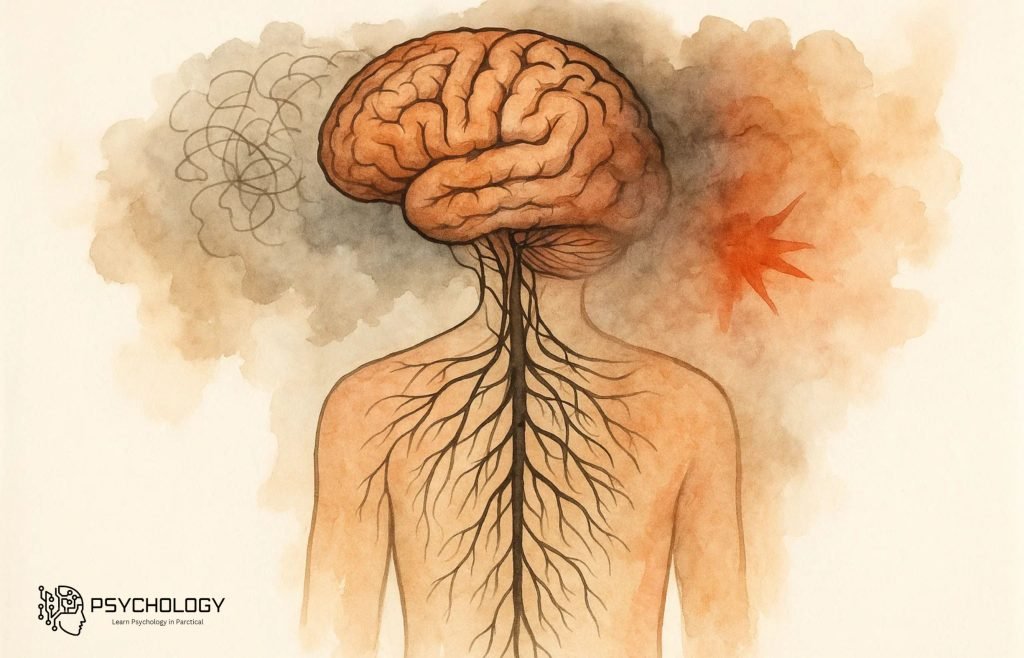
Many people feel pain or sickness without any clear medical reason. The tests come back normal, but the body still hurts. Why? This is where psychosomatic disorders come in. These conditions show how closely our mind and body are linked. When the mind is under stress, the body feels it too.
Let’s look at what psychosomatic disorders are, how they appear in daily life, and how we can treat them with kindness and care especially in South Asian families.
What Are Psychosomatic Disorders?
Psychosomatic disorders are physical problems that are caused or made worse by mental stress. The word itself comes from two parts:
“Psyche” means mind
“Soma” means body
These disorders are not fake or imaginary. The pain is real. But the cause often starts in the mind.
Meaning of “Psychosomatic”
Think of it like this: when you are very worried, your heart beats fast. When you feel scared, you might sweat or tremble. These are small examples of how emotions affect the body. Psychosomatic disorders are like that but stronger and longer-lasting.
Common Misunderstandings
Many people think the person is making it up or acting. That is not true. Just because there is no broken bone or visible wound does not mean the person is not suffering. These disorders are real and need respect and care.
Real-Life Examples You Might Recognize
Let’s see how this can happen in everyday life.
Example: A Student with Exam Fear
Ali is a bright 16-year-old student in Lahore. Before exams, he starts getting stomach pain and nausea. Doctors find nothing wrong. But his fear of failure is so strong that his body reacts. His mind is scared, and the body speaks through pain.
Example: A Mother with Silent Pain
Sana is a housewife with three children. She feels tired all the time. Her back hurts. Tests are normal. But inside, she carries the burden of family stress, money worries, and no time for herself. Her pain is not fake it’s her body asking for help.
Causes of Psychosomatic Symptoms
So, what causes these disorders? Many things can lead to psychosomatic problems.
Emotional Triggers
These feelings can affect the body:
Fear
Sadness
Guilt
Anger
Worry
If these feelings are held inside for too long, the body suffers.
Cultural and Family Pressures
In South Asia, people often hide emotions. Parents expect too much. Girls are told to stay quiet. Boys are told not to cry. All this pressure builds up inside and can come out as physical pain.
Common Symptoms to Look Out For
Here are signs to watch for. These may be linked to emotional stress, not just physical illness
Physical Symptoms
Headaches
Back pain
Fatigue (always tired)
Stomach problems
Chest tightness
Dizziness
Skin rashes
Mental Symptoms
Anxiety
Mood swings
Trouble sleeping
Feeling helpless
Always worrying
How Psychosomatic Disorders Are Diagnosed
These disorders are not easy to spot. Many people go to doctor after doctor without finding a clear reason.
Medical Tests
Doctors often check for:
Blood tests
X-rays
Scans
But when nothing shows up, it can feel frustrating. This is when emotional health must be considered.
Psychological Evaluation
A psychologist or counselor may talk to the person to understand:
Life stress
Family situation
Work or school issues
Emotional pressure
They connect the dots between mind and body.
Helpful Treatments and Coping Methods
There is no magic pill. But help is available. The right mix of care, rest, and emotional support can bring real relief.
Counseling and Therapy
Talking really helps. Here are some useful methods:
Cognitive Behavioral Therapy (CBT): Helps change negative thoughts
Supportive Counseling: Offers emotional support
Art or Talk Therapy: Helps express feelings without fear
Stress-Relief Activities
You don’t need expensive tools. These simple habits can help:
Breathing exercises
Writing your feelings in a notebook
Stretching or light yoga
Listening to calming sounds
Taking breaks from phone and TV
Support from Family
Love and care from family members can do wonders. Here’s what helps:
Listen without judging
Don’t say “It’s nothing” or “Be strong”
Let the person rest
Talk kindly
Avoid pressure about school, marriage, or job
“The body cries out what the mind tries to hide.”
Why These Disorders Are Common in South Asia
In countries like Pakistan, India, and Bangladesh, psychosomatic disorders are more common but often hidden. Let’s see why.
Emotional Expression Is Often Blocked
In many homes, crying or sharing pain is seen as weakness. This leads to emotional block. But emotions don’t disappear they turn into body signals.
Mental Health Stigma
Sadly, many people fear going to a psychologist. They don’t want to be called “crazy.” This fear delays treatment and increases pain.
When to Seek Help
Not every ache is psychosomatic. But if someone feels pain or sickness often with no clear medical reason, it’s time to consider emotional help.
Signs You Shouldn’t Ignore
Pain with no cause found
Symptoms that come before or after stress
Always feeling tired
Aches that move from place to place
Sadness or fear that won’t go away
Talk to a psychologist. Early help brings faster healing.
Final Thoughts from a South Asian Lens
Our culture values strength and silence. But silence can hurt. Psychosomatic disorders show us that the mind and body work as one. When we take care of our emotions, the body also feels better.
So next time someone says, “It’s all in your head,” remember this:
Yes, it starts in the head. But it lives in the body.
And both need care, kindness, and healing.

Founder of psychology.websolution.pk, Muhammad Nawaz writes simple, helpful articles on mental health and human behavior for South Asian readers.


